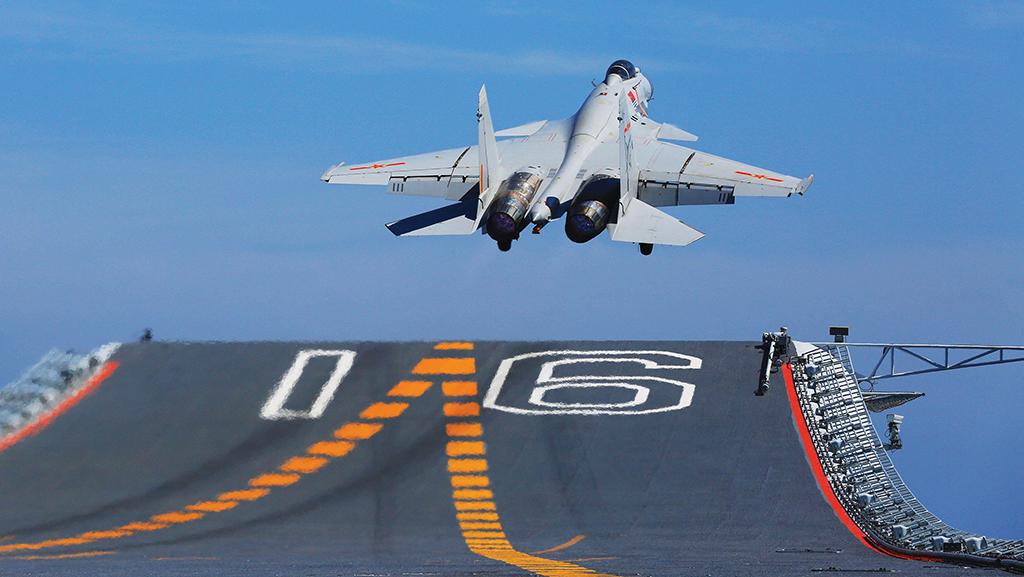
The carrier Liaoning, like its half-sibling the Shandong, launches J-15s with a ski jump.
China’s third aircraft carrier, the Fujian, is just about complete. It has tested its machinery in harbor and is due to go to sea this year. Successful sea trials would then reportedly clear the way for construction of a fourth aircraft carrier, presumably a sibling to the Fujian. A fifth may not be far behind.
China’s carrier-capable aircraft fleet is set to expand more than proportionally, with shipborne fighter numbers quadrupling over the coming decade, according to an Aviation Week assessment led by Senior Military Defense Analyst Matt Jouppi (see chart).
- Shipboard fighter force will quadruple by 2033
- Third aircraft carrier is almost ready for sea trials
- Multiple aircraft types will add complexity for the carrier organization
As with other Chinese military aviation services, however, the carrier force will likely suffer from complexity, with many aircraft types and versions. There will also be at least two ship classes.
In 2020, the U.S. Navy forecast that the Chinese aircraft carrier fleet would reach five ships by 2030 and six by 2040. That forecast was evidently still current in 2022, because the U.S. Navy passed it on to the U.S. Congressional Research Service for a report published that year.
Three of the 2030 ships have been built: the Liaoning and Shandong, which are half-siblings each equipped to launch aircraft from a ski jump, and the Fujian, which uses electromagnetic catapults. All three are propelled by steam turbines fed by oil-fired boilers.
Aviation Week’s estimate of Chinese aircraft numbers presumes the fourth ship will be a sibling of the Fujian and the fifth will be the first of a nuclear-propelled class.
So far there is no sign of the fourth ship being under construction. Hong Kong’s South China Morning Post last year quoted a source close to the military as saying construction would not begin until the Fujian had run sea trials—a plausible precaution, especially since the navy will want to verify catapult performance.
State media have reported progress in testing the Fujian and the plan to begin sea trials this year.
The Fujian has taken at least six years to build, but the Shandong needed only 4.5 years—though it was not commissioned until another 1.6 years had passed. So getting the fleet of completed ships, not necessarily commissioned, to five by 2030 seems possible if fabrication of the fourth and fifth ships begins not much later than next year. Conceivably, Dalian Shipbuilding, the yard in northeastern China that built the Liaoning and Shandong, could construct one of the next two carriers while Fujian’s builder, the Shanghai Jiangnan yard, builds the other.
Stepping up to building two carriers at the same time should be possible. From 1952-57, three U.S. shipyards laid down six carriers comparable to the Fujian and built each in an average of 3.6 years. The building time for the first U.S. nuclear carrier, laid down in 1958, was similar.
However, as those ships were commissioned, the U.S. Navy already had a huge and thriving naval aviation organization that could rapidly make them operational. If the Chinese Navy’s fourth and fifth aircraft carriers are completed close together late in the decade, the service may struggle with a steep ramp-up in operations.
The Chinese Navy now has an estimated 77 Shenyang J-15s of all versions and six Xian KJ-600 radar aircraft, analogous to the Northrop Grumman E-2 Hawkeye and suitable only for ships with catapults. A new fighter type from Shenyang, apparently called the J-35, is in development.
To equip the future aircraft carrier fleet, the shipborne fighter force should grow to 317 aircraft by 2033, according to Aviation Week estimates. That force is likely to be split about equally between the J-15, which by then would be out of production, and the J-35.
In addition, there should be 26 KJ-600s, while about 100 helicopters would probably be needed for the aircraft carriers, not counting others elsewhere in the navy. The forecast does not include the introduction of transport airplanes based on the KJ-600 design, though that is a clear possibility.
By 2033 Chinese carrier air wings and land-based training squadrons supporting them should have more than 440 aircraft.
Complexity is baked into the force, however, pushing up costs and training and support challenges. Much of that complexity comes from the shortcuts by which the Liaoning and Shandong were acquired. The Liaoning was partly built by the former Soviet Union; buying it in that condition from Ukraine, China needed only to complete it. The Shandong then was constructed to basically the same design. The ships entered service in 2012 and 2019, respectively.
Apart from economies in design and construction, the shortcut avoided the need immediately to develop catapults. It also meant a carrier-borne fighter type, the J-15, could be created by copying and improving the Soviet Sukhoi Su-33, a member of the Flanker family.
But it meant that if the navy was determined quickly to gain the payload-radius advantages of catapult launches, as indeed it turned out to be, the young fleet would soon have to introduce a second ship class and new aircraft types and versions that suited it.
Mixed in with that was the launch of development of the J-35 to get a stealth fighter to sea, even though the J-15 had been flying from carrier decks for only a few years. And the J-15 has sprouted new versions at short production intervals, which often happens in Chinese military aircraft programs as the services strive to close the technology gap with the U.S. and Japan.
By 2026, the Chinese Navy is likely to have five J-15 versions plus an initial J-35 version. And the aircraft carriers will need two air-surveillance aircraft types: the Z-18J (or Z-18Y) helicopter for the Liaoning and Shandong and the KJ-600 airplane for the catapult-equipped ships.
While development of a transport derivative of the KJ-600 looks likely, the Liaoning and Shandong will presumably rely on a utility version of the Z-18, somewhat limiting their operations far from land. So far there is no sign of a dedicated tanker.
In a further air-wing complication, China’s aircraft carriers, unlike the the U.S. Navy’s, have what appears to be their own large anti-submarine helicopter design, the Z-18F. The anti-submarine version of the smaller Z-20, equivalent to the Sikorsky SH-60, is probably intended only for cruisers, destroyers and frigates.
The J-35 has descended from an early-2010s campaign by Shenyang to drum up business from the air force, beginning with internally funded development of a technology demonstrator that flew in 2012 and has been called the FC-31 and, unofficially, J-31.
Despite its initial air force market, the FC-31 design was confirmed to Aviation Week in 2018 as being under development for the navy (AW&ST Nov. 12-25, 2018, p. 24). To turn it into the J-35, it is being enlarged and structurally strengthened, very much as the Northrop YF-17 land-based fighter design of the 1970s was thoroughly revised to create the F/A-18 Hornet. Jouppi estimates the J-35 could enter service in 2026 or 2027.
The source who confirmed development of the design for the navy also said the air force was interested in the type. Air force orders, if they appear, would help justify the navy’s spending on development.
The original J-15 version, simply called the J-15, may have been succeeded in production by one often called the J-15A, with unconfirmed improvements.
The impending introduction of the Fujian class has provided the occasion for another J-15 version, because the plan for catapult launches required adaptation of the landing gear and, no doubt, the aircraft structure. Addition of a radar with an active, electronically scanned array is likely, along with integration of the PL-15 air-to-air missile. Those features should make the J-15B comparable to the Boeing F/A-18E/F Super Hornet carrying the Raytheon AIM-120D.
Aviation Week estimates that a handful of J-15Bs has been completed, though there should be 20 by the end of 2024. The Fujian will need those aircraft to work up to operational capability, probably over several years, and to train personnel for later catapult-equipped carriers. Simultaneous introduction of the KJ-600 will add to the task of making the Fujian operational, with the J-35 also coming along.
A two-seat J-15 version presumably used for training, the J-15S, was also built, and Avic’s Shenyang establishment is developing an electromagnetic attack version, the J-15D, analogous to the Boeing EA-18G Growler. Aviation Week analysts estimate that the J-15D will be the last J-15 version, as Shenyang prepares for volume production of the J-35.
The Z-18J has been needed for the Liaoning and Shandong because ski-jump departures would be impracticable (even unsafe) for the KJ-600, a propeller aircraft that would be in danger from strong thrust asymmetry if an engine failed during a short takeoff. But, as an airplane, it will offer greater flight performance and endurance than a helicopter can.
The complexity of this establishment contrasts starkly with the simplicity of the UK’s rejuvenated carrier force, which admittedly lacks some of the capabilities sought by China.
The Royal Navy has just one aircraft carrier class, one fighter type in one version (shared with the Royal Air Force) and one helicopter type also in one version, which is used for both anti-submarine work and radar air surveillance. Other helicopters for the British carriers come from elsewhere in the navy and army as required, including some for transportation between ship and shore.
How China’s carrier aviation establishment copes with the complexity of its ship and aircraft collection and the new task of catapult launches should become clearer as the Fujian works up to operational capability over the next few years.


